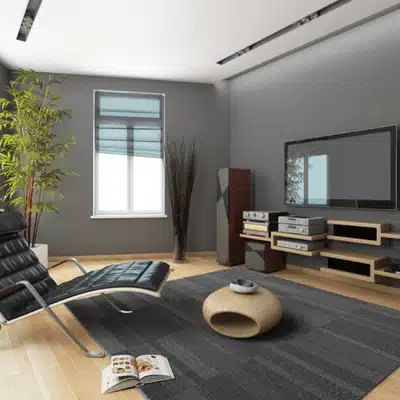Planning your dream entertainment space? You’re probably wondering what separates a media room from a home theater. These terms get mixed up a lot, but they’re actually quite different.
A media room is your flexible hangout spot. You watch movies, play games, and chat with friends all in one space. A home theater is built for one purpose: giving you that real cinema experience at home.
Let’s break down what makes each space unique. This comparison will help you pick the right setup for your lifestyle and budget.
Understanding the Media Room Definition

A media room is your all-in-one media entertainment hub. Think of it as a boosted family room where technology meets comfort. You can watch TV, stream shows, play video games, or host friends for game day.
The beauty of a media space is its flexibility. Windows? No problem. Normal lighting? That works too. This room doesn’t need total darkness to function well.
Most media room installations feature a large flat-panel TV as the main screen. Some setups add a media room projector that drops down when you want a bigger picture. Modern projection technology handles ambient light better than older systems.
The sound system usually stays discreet. You might find in-wall speakers, ceiling speakers, or a quality soundbar. Equipment doesn’t take over the room’s look.
Media room acoustics stay casual. You won’t see heavy soundproofing or acoustic panels covering every wall. The space connects to the rest of your home naturally.
Furniture here prioritizes comfort and function. A sectional sofa, some recliners, or comfy chairs work great. People can face the TV for movies or turn toward each other to talk. This flexible seating beats rigid theater rows for everyday use.
The room’s design blends with your home’s style. You’ll see nice cabinets, rugs, and wall art alongside the entertainment equipment. It’s a living space first, a movie room second.
What Makes a Home Cinema Room Different
A home theater exists for one reason: creating an immersive entertainment experience. This dedicated theater space copies what you get at the movies, but with better seats and no sticky floors.
These rooms get built away from main living areas. Basements, spare rooms, or custom additions work best. This separation gives you total control over light and sound.
Ambient light is the enemy here. You’ll find no windows or blackout shades that block every bit of outside light. Dimmable sconces or LED strips provide just enough glow for safety.
Media room screens pale next to what you get in a cinema room. We’re talking 120 inches or bigger, driven by high-end projectors calibrated for dark viewing. Some luxury setups now use giant micro-LED walls.
The audio setup is where home theater technology really shines. Walls, floors, and ceilings get treated for perfect acoustics. Soundproofing keeps your movie loud and your neighbors happy.
These rooms feature serious surround sound systems with seven, nine, or even more speakers. Overhead Atmos channels put you inside the action. Powerful subwoofers shake your seat during explosions.
Home theater seating faces one direction: the screen. Rows of plush recliners or cinema seats line up for perfect sight lines. Raised platforms lift back rows so everyone sees clearly.
The whole theater space follows a cinema theme. Dark colors prevent light reflections. Movie posters or acoustic panels decorate the walls. Some high-end designs add curtains or marquee signs.
Everything serves the viewing experience. You won’t find much else competing for attention.
Key Differences in Design and Functionality

Space Requirements and Layout
Media rooms work in existing living areas. You don’t need a separate room. A corner of your family room or part of your basement can become your entertainment space.
Home theaters need their own dedicated theater space. Plan for at least 300 square feet if you want proper room size for seating and screen distance. The isolation matters for both light control and acoustics.
Purpose and Daily Uses
A media room handles multiple jobs. Kids play video games in the afternoon. The family watches the big game together. Friends come over to chat with something streaming in the background.
A home theater room serves one function: delivering the best possible viewing experience. You dim the lights, silence phones, and focus on the screen. Every visit feels like an event.
Technology and Equipment
Media rooms use lighter setups. A streaming device, game console, AV receiver, and TV cover most needs. The gear stays hidden in cabinets to keep things tidy.
Home theaters go all-in on equipment. High-end receivers, multiple amplifiers, calibrated projectors, and reference-grade speakers fill equipment racks. Some setups even include dedicated media servers for your collection.
Sound and Lighting Control
Media room lighting balances entertainment with everyday life. Normal ceiling lights, lamps, and maybe some dimmer switches handle most situations. You can darken things for movies but don’t need total blackout.
Home theater lighting controls every photon. Blackout curtains, automated shades, and carefully placed accent lighting create the right ambiance. Complete darkness is standard.
Comfort and Furniture
Media room furniture stays flexible. Sectionals, bean bags, and moveable chairs let people gather however they want. The layout works for watching movies or having conversations.
Theater space comfort comes from fixed recliners facing the screen. One or more rows lock in place. Raised platforms ensure clear sight lines for everyone.
Making Your Choice: Benefits and Comparison
Media Room vs Home Theater: Making Your Choice
Compare features, benefits, and costs to find your perfect entertainment space
Media Room
Home Theater
Which Option Fits Your Lifestyle?
Pick a media room if you want an entertainment space that adapts to daily life. Families with varied interests love this flexibility. You get great media entertainment without sacrificing the room’s other uses.
Choose a home theater if movies and shows deserve your full attention. This dedicated screening room delivers immersion that casual setups can’t match. Perfect for true film fans.
Your available space matters too. Limited square footage? A media room makes better use of shared areas. Got a spare room collecting dust? That’s your future home cinema room.
Budget plays a role in this comparison. Media rooms cost less upfront and let you upgrade over time. Home theaters require bigger initial investments but deliver immediate wow factor.
Some people do both. A media room handles everyday needs while a home theater provides special occasion viewing. Technology improvements mean both options perform better than ever. The differences come down to flexibility versus immersion.
Media Room Ideas and Upgrades
Already have a basic TV room? A media room makeover can bring theater-like features without major construction. Add motorized blackout shades for better light control. Upgrade to a proper 5.1 speaker setup for improved sound.
Smart lighting systems let you create different scenes. Movie mode dims everything. Game night keeps some lights up. These small changes boost your media room experience significantly.
Consider a retractable projector screen that hides when not needed. Your space stays multi-functional but gains big-screen capabilities for special occasions.
Ready for another media room makeover? Converting a space into a full home cinema room requires more work. You’ll add soundproofing, install a permanent screen, and commit the room to one purpose focused on design excellence.
Transform Your Entertainment Experience Today

Whether you choose a media room or home theater, you’re investing in how you relax and enjoy home entertainment. Both deliver great benefits when designed right based on your concept of the perfect setup.
Media rooms give you versatility and blend into daily life. Home theaters create magic through dedicated design and technology. Neither choice is wrong if it fits your lifestyle and uses.
The functionality of each option serves different needs. Consider your purpose before making a decision. Both spaces can include impressive features and deliver an amazing media room experience or home theater experience.
Ready to build your perfect entertainment space? Work with experienced professionals who understand both media room installations and home theater design. They’ll help you maximize your space, pick the right equipment, and create something you’ll love for years. Don’t wait another day watching movies on a basic setup when you could have a custom cinema room or media room designed exactly for you.
Professional integrators bring expertise in room calculations, equipment selection, and setup optimization. Get started today and transform how you enjoy entertainment at home.
Frequently Asked Questions
What’s the main difference between a media room and home theater?
A media room serves multiple purposes in a shared living space with natural lighting and flexible furniture. A home theater is a dedicated cinema room built only for watching movies and shows with maximum immersion in a controlled environment.
Can I have good surround sound in a media room?
Yes, but it won’t match a dedicated theater space. Media rooms can include 5.1 or 7.1 speaker systems that sound great for most viewers. Home theaters go further with acoustic treatments and more powerful equipment calibrated to the space.
Which costs more to build?
Home theaters typically cost more upfront because they need specialized construction, soundproofing, and high-end equipment. Media rooms offer more budget flexibility since you can start basic and add technology features over time as your needs grow.
How much space do I need for each option?
Media rooms work in 250-300 square feet of shared living space. Dedicated home theaters perform best with 300-400 square feet or more in an enclosed room. Your available room size helps determine which concept fits better for your home.


